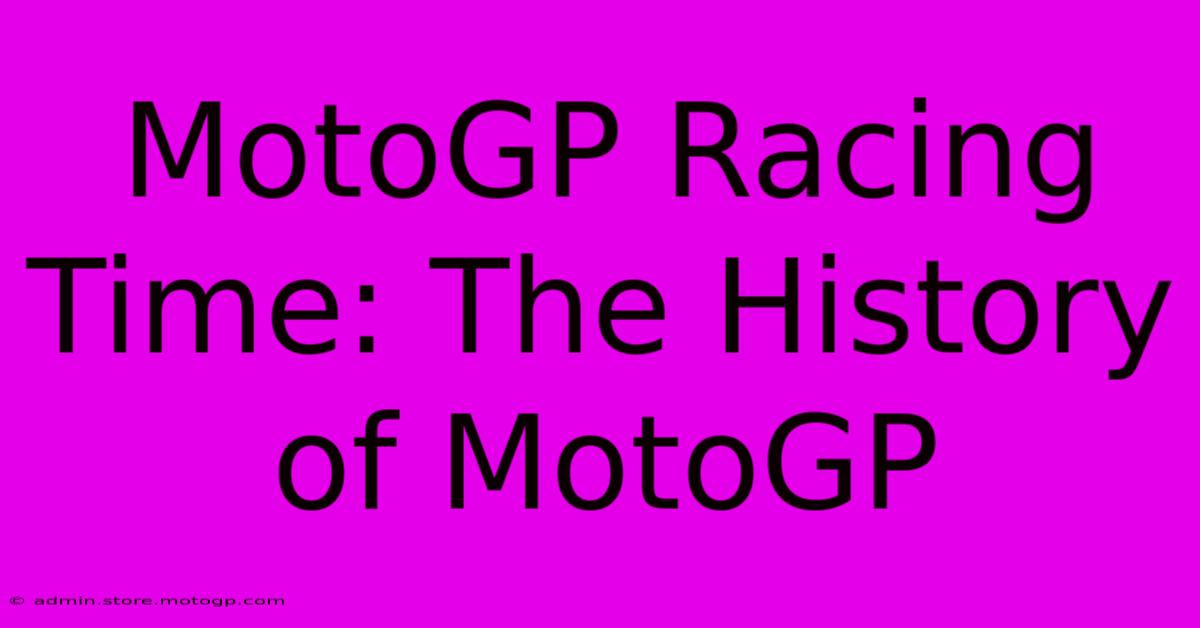MotoGP Racing Time: The History Of MotoGP

Table of Contents
MotoGP Racing Time: The History of MotoGP
MotoGP, the pinnacle of motorcycle road racing, boasts a rich and thrilling history spanning over seven decades. From humble beginnings to its current global phenomenon status, the sport has evolved dramatically, captivating audiences worldwide with its speed, skill, and intense competition. This article delves into the fascinating history of MotoGP, exploring its key eras, iconic riders, and pivotal moments that shaped the sport we know and love today.
The Early Days: From the Isle of Man TT to Grand Prix Racing
The origins of MotoGP can be traced back to the Isle of Man TT (Tourist Trophy), a grueling road race held annually since 1907. This perilous event, characterized by its challenging course and high speeds, established the foundation for motorcycle grand prix racing. The first official Grand Prix motorcycle racing world championship wasn't established until 1949, marking a pivotal moment in the sport's history. These early races featured a variety of motorcycle classes, reflecting the diverse landscape of motorcycle technology at the time. Legendary riders like Giacomo Agostini began to emerge, cementing their place in MotoGP history with their exceptional skill and countless victories.
The Rise of Giacomo Agostini: A Dominant Force
Giacomo Agostini, often hailed as the greatest motorcycle racer of all time, dominated the sport throughout the 1960s and 1970s. His incredible record of 15 world championships, spanning multiple classes, remains unmatched. His fierce competitiveness and unparalleled skill set the standard for future generations of racers. Agostini’s legacy extends beyond his championships; he embodies the spirit of the sport – dedication, skill, and relentless pursuit of victory. He remains a powerful symbol of MotoGP's golden age.
The Evolution of MotoGP: Technological Advancements and Rule Changes
Over the decades, MotoGP has undergone significant transformations. Technological advancements have led to increasingly sophisticated machines, pushing the boundaries of speed and performance. The introduction of different engine capacities and regulations has also shaped the competitive landscape, creating new challenges and opportunities for riders and manufacturers alike. The shift towards modern four-stroke engines in the early 2000s was a significant turning point, marking a new era in MotoGP technology.
The Four-Stroke Era and the Rise of Valentino Rossi
The transition to four-stroke engines brought a new wave of innovation and fierce competition. This era saw the emergence of Valentino Rossi, another iconic figure who captivated fans globally with his charisma and exceptional riding skills. Rossi's dominance throughout the 2000s solidified his position as one of the greatest, showcasing the ever-evolving nature of MotoGP. His rivalry with other top racers provided some of the most memorable and exciting races in MotoGP history.
Modern MotoGP: Global Reach and Intense Competition
Today, MotoGP is a truly global sport, with races held across continents, attracting millions of fans worldwide. The level of competition is fierce, with numerous talented riders representing various manufacturers, each striving for championship glory. The technological advancements in motorcycle engineering continue to push the boundaries of performance, leading to breathtaking speeds and spectacular racing.
The Current Landscape: A Fight for Supremacy
The current MotoGP championship is a thrilling battleground, with several top riders vying for the title. The constant technological upgrades, strategic team management, and individual rider skill all play crucial roles in determining the ultimate winner. This ongoing competition ensures the sport remains exciting, dynamic, and relevant to a global audience, keeping MotoGP at the forefront of motorcycle racing.
The Future of MotoGP: Innovation and Sustainability
Looking ahead, MotoGP's future looks bright. The sport continues to innovate, seeking ways to enhance the racing experience while also embracing sustainable practices. The introduction of new technologies and regulations aimed at improving safety and environmental impact underlines a commitment to the future of the sport. The constant drive for improvement will ensure that MotoGP continues to thrive and entertain for many years to come.
In Conclusion:
The history of MotoGP is a compelling narrative of evolution, innovation, and fierce competition. From its humble beginnings on the Isle of Man to its current global status, the sport has captivated audiences with its speed, skill, and drama. The legacy of legendary riders and the ongoing technological advancements ensure MotoGP will continue to be a thrilling spectacle for generations to come. The quest for speed, precision, and victory remains the driving force, propelling MotoGP into an exciting future.

Thank you for visiting our website wich cover about MotoGP Racing Time: The History Of MotoGP. We hope the information provided has been useful to you. Feel free to contact us if you have any questions or need further assistance. See you next time and dont miss to bookmark.
Featured Posts
-
Edge Of Your Seat Us Grand Prix Sprint Time Revealed
Feb 18, 2025
-
The Ultimate Cota Concert Guide
Feb 18, 2025
-
Cota Qualifying Master The Track
Feb 18, 2025
-
Moto Gp Classification The Key To Understanding The Season
Feb 18, 2025
-
Moto Gp Replicas For The Discerning Rider
Feb 18, 2025
